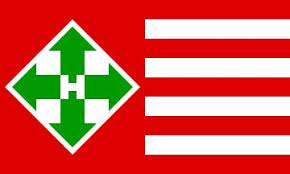Returning from Budapest this weekend, I was surprised - if not frightened - by the police presence on and around my train. As I climbed aboard, two armed Budapest policemen followed me, and proceeded to check or lightly search the entire length of the train. It wasn't clear what they were looking for, or if they were looking for anything at all. As they worked, ten to fifteen other cops stood alongside the train car armed and dressed in full riot gear. In these situations, I try to normally take my social cues from the Hungarians around me: if the nénis (old ladies, literally "aunties") are whispering wildly or if the old men stand up and puff their chests, it is generally a good idea to get anxious. But no one on the train looked too worried - so I tried to forget about it and continue puffing away at my book. After all, several of the policemen were puffing away at the Hungarian hobby of choice, Marlboro Lights.
About half way through the three hour ride, I got up to stretch my legs. As I walked to the end of the car, I noticed three men (all in the nascent beer belly stage) wearing black cargo shorts,
boots, and black t-shirts - with the Árpád zászló across the chest.

A quick note: The Árpád zászló (the Arpad flag) was the flag of the first Hungarian dynasty, the Árpád dynasty. Though the dynasty only lasted about three centuries, the flag is in use today as a small part of the

Hungarian state seal. According to the state, the four silver stripes represent the "four rivers of Hungary - the Duna, the Tisza, the Dráva, and the Sáva." No official explanation is given for the four red ones between them...

The Árpád flag was also used by the Arrow Cross Party in the 1940s - Hungary's equivalent of the Nazis. Though is disappeared after World War II, it has returned to popularity in recent years as a symbol of the right-wing, which is increasingly synonymous in Hungary with the ultra-nationalists.
The Magyar Garda, a nascent 'militia' of formed by ultra-nationalists to "defend a physically, spiritually and intellectualy defenceless Hungary," is perhaps the most fervent user of the Árpád flag. Their goal has also been summed up as keeping "Hungary for the Hungarians," and they act as the uniformed arm of the rising political party Jobbik (which loosely translates to "Better"). They have been swearing in new members at induction ceremonies around Hungary (often in places of historical and cultural significance) for the past two years, though they were recently outlawed by the Supreme Court on July 2, 2009. Technically, since the group's prohibition by the court, they are no longer allowed to congregate or wear the uniform in public. However, their activities have continued (albeit on private property), and often involves the donning of the official uniform: black combat pants, black boots, white shirt, and a black vest with an Árpád-style shield on the left chest and back.
This brings us back to the three men on the train: wearing all black with the Arpad flag t-shirt. While an uncommon t-shirt design (for that matter, it is very popular on all types of consumer products: bumper stickers, pins, necklace and bracelet charms, bandannas, coffee mugs, etc...the direct Hungarian equivalent of the Stars and Bars), it is uncommon to see three men all wearing the same one at the same time. Was this what the police were looking for?
When we arrived in Debrecen three hours later, I hopped off the train and to my surprise came face-to-face with another Hungarian policemen: except this one was completely covered in Teflon (even his steel-toed boots had their own covers) armor with a bullet-proof motorcycle-style helmet. He too was holding a rather large gun, and had a truncheon attached to his leg armor. He had brought his friends, too: about twenty-five of them, spaced every two meters along the side of the train. They looked like a row of transformers (woo hoo early nineties toy shout-out!). I walked through the ranks, and proceeded on my way home, unstopped, though saw more cops, cop cars, and army vans in the parking lot.
I still am unsure if the police presence was actually linked to the three men in pseudo-Magyar Garda uniform. As I mentioned above, it is truly a common symbol in contemporary Hungary, for better or for worse (probably worse). Nonetheless, as I was out on my evening run/jog/walk/crawl, I noticed the stadium and bars filled for a soccer match. Apparently, it was the Ferencvaros (also known as "Fradi," a Budapest team) versus Debrecen game. Though I don't know exactly where the Venn diagram of soccer hooligans and ultra-nationalists meets, it is a safe bet there is quite a bit of overlap.
Relevant Links:

No comments:
Post a Comment